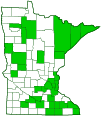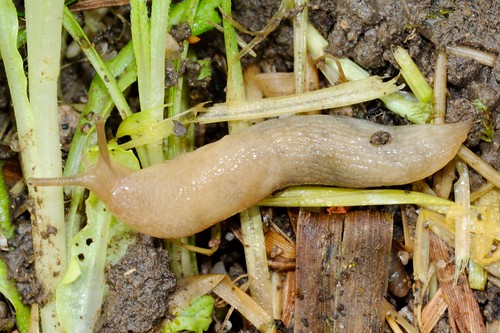gray field slug
(Deroceras reticulatum)
Conservation • Description • Habitat • Biology • Distribution • Taxonomy
Conservation Status |
|
|||||||
| IUCN Red List | not listed |
|||||||
| NatureServe | NNA - Not applicable |
|||||||
| Minnesota | not listed |
|||||||
Description |
||
Gray field slug, also known as milky slug, is a common, exotic, terrestrial, smooth land slug. It is native to northern Europe, North Africa, and the Atlantic islands. It was introduced into North America and now occurs across the continent. It is most common in southern Canada and northern United States. It can be a serious crop pest, but is not listed as invasive nationally or in Minnesota. It is usually found above ground but under stones or leaf litter in open areas, especially cultivated areas. The adult is stout, 1⅜″ to 2″ long and slender when stretched out, short and bell-shaped when contracted. It has no visible external shell. The skin is thick and is covered with raised areas (tubercles) and grooves, giving it a granular appearance. The tubercles may be white, cream, gray, or tan. The grooves are more or less covered with darker brown or gray flecks. The saddle-shaped covering on the front of the body (mantle) is short but usually covers more than one third of the body. The breathing pore (pneumostome) is on the right hand side of the rear quarter of the mantle. It is difficult or impossible to see if not open. When open, it has a raised, pale border. Concentric wrinkles on the mantle form a fingerprint-like pattern. The pattern is off-center, centered on the pneumostome. There is a short, longitudinal ridge (keel) at the end of the tail. The underside of the foot (sole) has three distinct longitudinal regions. The central region is gray, the lateral regions are whitish to grayish-yellow. The mucus is clear but can become white when the slug is disturbed. |
||
Size |
||
Total length: 1⅜″ to 2″ |
||
Similar Species |
||
This is the only Deroceras species that can change its mucus from clear to white. Marsh slug (Deroceras laeve) is smaller, no more than 1⅜″ in length, and darker, smoky bluish-black. Some other Deroceras species are identical in appearance and can only be distinguished when dissected by the male genitalia. However, they do not occur in Minnesota. |
||
Habitat |
||
Agricultural fields, parks, gardens, roadsides, and other open, cultivated areas |
||
Biology |
||
Season |
||
Probably two generations per year |
||
Behavior |
||
Gray field slug is active at night. During the day it remains concealed in the ground. It does not burrow but uses existing crevices and worm holes. At night, it climbs onto vegetation to feed. When at rest, the body is contracted and the tentacles are retracted. When disturbed, it exudes white mucus over its entire body, leading to one of its common names, milky slug. |
||
Life Cycle |
||
Eggs and/or hatchlings overwinter in soil. Adults die in the fall. Sources disagree about the life cycle of gray field slug. Some sources say that adults overwinter. Others say the mostly eggs, sometimes juveniles, overwinter. Still others that hatchlings overwinter and adults die in the fall. |
||
Food |
||
Fresh leaves, fruits, and seedlings |
||
Distribution |
||||
|
Sources |
|||
| 8/21/2022 | ||||
Nativity |
||||
Native to Europe and North Africa. Introduced. |
||||
Occurrence |
||||
Common |
||||
Taxonomy |
|||
| Class | Gastropoda (gastropods) | ||
| Subclass | Heterobranchia | ||
| Infraclass | Euthyneura | ||
| Subterclass | Tectipleura | ||
| Superorder | Eupulmonata | ||
| Order | Stylommatophora (common land snails and slugs) | ||
Suborder |
Helicina (helicinan snails and slugs) | ||
| Infraorder | Limacoidei | ||
Superfamily |
Limacoidea | ||
Family |
Agriolimacidae | ||
| Subfamily | Agriolimacinae | ||
Genus |
Deroceras (smooth land slugs) | ||
Synonyms |
|||
Agriolimax agrestis |
|||
Common Names |
|||
field slug gray field slug gray fieldslug grey field slug milky slug |
|||
Glossary
Mantle
On gastropods: the fleshy, membranous covering of the front of the body.
Tubercle
On plants and animals: a small, rounded, raised projection on the surface. On insects and spiders: a low, small, usually rounded, knob-like projection. On slugs: raised areas of skin between grooves covering the body.
Visitor Photos |
|||||
Share your photo of this gastropod. |
|||||
| This button not working for you? Simply email us at info@MinnesotaSeasons.com. Attach one or more photos and, if you like, a caption. |
|||||
Tricia |
|||||
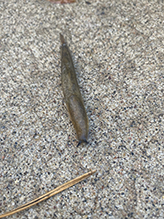 |
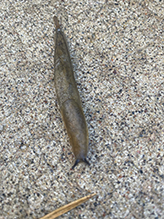 |
||||
Alfredo Colon |
|||||
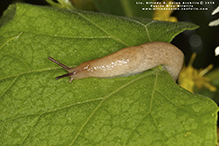 |
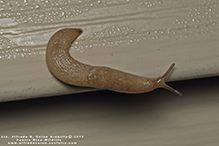 |
||||
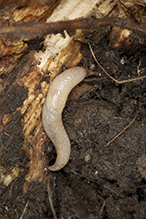 |
|||||
MinnesotaSeasons.com Photos |
|||||
|
|||||

Visitor Videos |
|||
Share your video of this gastropod. |
|||
| This button not working for you? Simply email us at info@MinnesotaSeasons.com. Attach a video, a YouTube link, or a cloud storage link. |
|||
Other Videos |
|||
| Grey field slug (Deroceras reticulatum) - 2015-05-18 Westdelta |
|||
About
Published on May 19, 2015 Deroceras reticulatum, common names the 'grey field slug' and 'grey garden slug', is a species of small air-breathing land slug, a terrestrial pulmonate gastropod mollusk in the family Agriolimacidae. De gevlekte akkerslak (Deroceras reticulatum) is een landnaaktslak uit de familie akkerslakken. Er zijn verschillende namen voor deze soort, zoals grauwe veldslak, grauwe aardslak, akkeraardslak en melkslak(je). Geo location: 52.05226 4.24792 |
|||
| Deroceras reticulatum (Müller, 1774) Gray Fieldslug Chin Frank |
|||
About
Published on Feb 8, 2015 Downhill side of NC-105; under cinder blocks on shaded back lawn of small frame office building, Foscoe, Watauga County, North Carolina.The slug measured about 45 mm. in length.Also see: http://www.jaxshells.org/ret29b.htm and http://www.jaxshells.org/norw22a.htm |
|||
| Deroceras reticulatum - Grey Garden Slug Mating - Foreplay Ritual and Climax Lisa Marie Carrick |
|||
About
Published on Sep 27, 2018 Here’s some video that I took a couple of years ago of a couple of grey garden slugs (Deroceras reticulatum) slugs mating. This is the sped up version. The courting phase can take several hours, but luckily I usually seem to come across the couples near the end of their courting (about an hour before copulation). During courting, they trail each other in a circle - swinging their tails (this is mostly during the beginning of courtship and during precourtship), "kissing"/biting, and touching and stroking each other with their penises. Over the hours of courtship, they begin by circling quickly and slow down over time until just before copulation. During copulation. Sperm is transferred externally between both slugs. My favourite part is during copulation is when they "climax" and it looks like their penises explode, and what I believe is increased blood flow can be seen down the back of the head of the snails. For more videos like this, follow me on IG at @garbage.nobility and/or check my personal arthropod related tag #garbagearthropodsetc to see all of my arthropod related posts in one place. |
|||


Created: 1/16/2019
Last Updated:

